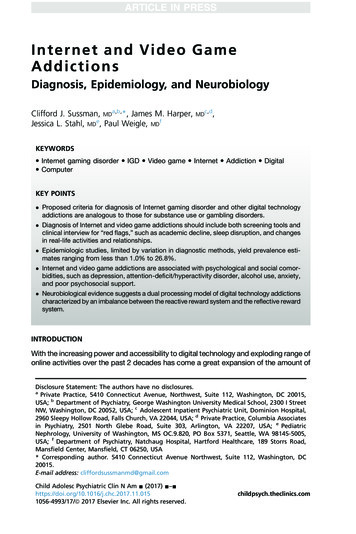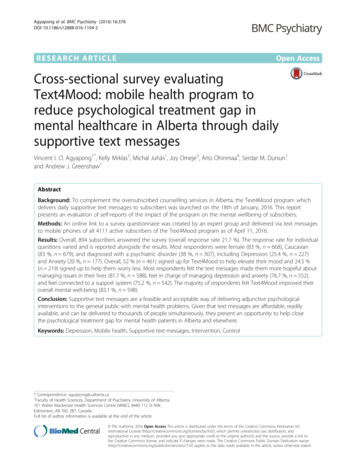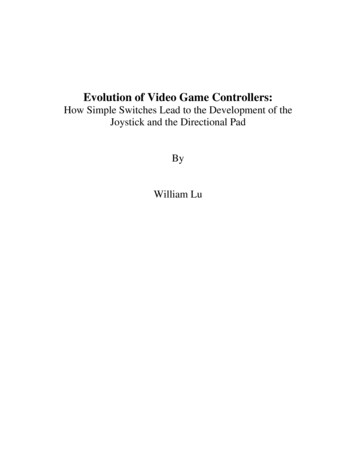
Transcription
Inter n et and Video GameAddictionsDiagnosis, Epidemiology, and NeurobiologyClifford J. Sussman, MDa,b,*, James M. Harper,Jessica L. Stahl, MDe, Paul Weigle, MDfMDc,d,KEYWORDS Internet gaming disorder IGD Video game Internet Addiction Digital ComputerKEY POINTS Proposed criteria for diagnosis of Internet gaming disorder and other digital technologyaddictions are analogous to those for substance use or gambling disorders. Diagnosis of Internet and video game addictions should include both screening tools andclinical interview for “red flags,” such as academic decline, sleep disruption, and changesin real-life activities and relationships. Epidemiologic studies, limited by variation in diagnostic methods, yield prevalence estimates ranging from less than 1.0% to 26.8%. Internet and video game addictions are associated with psychological and social comorbidities, such as depression, attention-deficit/hyperactivity disorder, alcohol use, anxiety,and poor psychosocial support. Neurobiological evidence suggests a dual processing model of digital technology addictionscharacterized by an imbalance between the reactive reward system and the reflective rewardsystem.INTRODUCTIONWith the increasing power and accessibility to digital technology and exploding range ofonline activities over the past 2 decades has come a great expansion of the amount ofDisclosure Statement: The authors have no disclosures.aPrivate Practice, 5410 Connecticut Avenue, Northwest, Suite 112, Washington, DC 20015,USA; b Department of Psychiatry, George Washington University Medical School, 2300 I StreetNW, Washington, DC 20052, USA; c Adolescent Inpatient Psychiatric Unit, Dominion Hospital,2960 Sleepy Hollow Road, Falls Church, VA 22044, USA; d Private Practice, Columbia Associatesin Psychiatry, 2501 North Glebe Road, Suite 303, Arlington, VA 22207, USA; e PediatricNephrology, University of Washington, MS OC.9.820, PO Box 5371, Seattle, WA 98145-5005,USA; f Department of Psychiatry, Natchaug Hospital, Hartford Healthcare, 189 Storrs Road,Mansfield Center, Mansfield, CT 06250, USA* Corresponding author. 5410 Connecticut Avenue Northwest, Suite 112, Washington, DC20015.E-mail address: cliffordsussmanmd@gmail.comChild Adolesc Psychiatric Clin N Am - (2017) 4993/17/ª 2017 Elsevier Inc. All rights reserved.childpsych.theclinics.com
2Sussman et altime youth regularly spend engaging with it. The 2015 Common Sense Media UseCensus found that teens ages 13 to 18 spent a daily average of more than 6.5 hourson screen entertainment (including TV, smart phones, computers, video games, streaming videos, and so forth) and the daily average of tweens ages 8 to 12 was more than 4.5hours.1 This represents a significant increase in youth screen habits, with a substantialminority developing excessive, problematic habits that interfere with functioning inwork, academics, relationships, and other domains. The concept that it is possible todevelop a behavioral addiction to the Internet was first proposed in the 1990s,2 and interest in this topic has grown along with the influence of the Internet in our lives.Numerous researchers have investigated Internet and video game addictions(“IVGA” for the remainder of this article) in the past decade.3–6 A wide variety of onlineactivities are engaging enough to be potentially addictive, including video games, social media, smartphone use, texting, streaming videos, and online pornography.Notably, we omitted online gambling, as its related addiction is typically classifiedas a subtype of gambling disorder. The subtype of IVGA that research has validatedmost is video game addiction, particularly to games played online, such as massivelymultiplayer online games (MMORPGs). Increased acceptance of video game addiction led the 2013 inclusion of “Internet gaming disorder” (IGD) in the Diagnostic andStatistical Manual of Mental Disorders, Fifth Edition (DSM-V) as a “condition for furtherstudy.”7 A growing body of evidence indicates commonalities between IVGA,including IGD, and more well-established addictions, including substance use disorders and gambling disorder. This paper provides an updated review of IVGA, focusingon the significant body of research published in the 4 years since the proposal of IGD.We explore diagnosis, epidemiology, and neurobiology, much of which overlapssubstantially with that of substance use disorders. This article will help cliniciansimprove their awareness, understanding, and ability to diagnose IVGA.DIAGNOSIS OF INTERNET GAMING DISORDER AND OTHER TYPES OF INTERNETAND VIDEO GAME ADDICTIONSBehavioral addictions may be conceptualized as an excessive, uncontrollable,“repeated behavior leading to significant harm or distress.”8 Young2 initially conceptualized Internet addiction in 1996 using criteria adapted from those of pathologicgambling, the only behavioral addiction recognized in the Diagnostic and StatisticalManual of Mental Disorders, Fourth Edition, Text Revision. Those meeting criteriahad extreme online habits causing academic, occupational, relationship, and/or financial dysfunction.2 Young’s2 original diagnostic questions served as a basis for manysubsequent rating scales and proposed criteria for IVGA.Most studies of IVGA use similar criteria, based on a conversion of DSM criteria or awell-validated scale for diagnosing substance use disorder or pathologic gambling.Resultant IVGA assessment scales and diagnostic criteria have been adapted for specific subtypes, including addiction to online gaming, the Internet in general, smartphones, online pornography, and others.9–16 Griffiths’17 similar conceptualization ofaddiction, based on the key components of salience, mood modification, tolerance,withdrawal, conflict, and relapse, forms the basis for a number of IVGA assessmentscales as well.18–22Romano and colleagues23 demonstrated that Internet addicts are more likely thannonaddicts to experience withdrawal symptoms following a brief 15-minute Internetexposure. A pronounced decline in mood prompted addicts to rapidly reengagewith the Internet. Addicts were also more likely to have depressive, impulsive, andautistic traits.
Internet and Video Game AddictionsIn 2013, the American Psychological Association proposed IGD, a type of IVGArelated exclusively to online video game play, in the DSM-V as a “condition requiringfurther study” using comparable criteria (Box 1).7These IGD criteria are nearly identical to those of the DSM-V’s substance use disorder and gambling disorder, although the threshold for IGD is significantly higher. Inaddition to persistent use leading to distress or impairment, substance use disorderrequires only 2 of 11 additional symptoms for diagnosis. Pathologic gambling requires4 of 9, whereas IGD requires 5 of 9. IGD concerns only addiction to online videogaming, and excludes that of other potentially addictive screen habits included inIVGA. The DSM-V IGD criteria as written are stricter than most definitions of IVGA,and therefore yield lower prevalence rates, more reflective of moderate to severeaddiction than a mild addiction or “at-risk” habit, as outlined later in this article.Other studies of IVGA that were not limited to Internet gaming also validated theresultant loss of function and detrimental outcomes for the affected individual (eg,distress, withdrawal, tolerance, lying, and conflict resulting from use), as well as othersymptoms, such as preoccupation and using the Internet to escape negative feelings.24,25 When evaluating a case of possible IVGA in a patient who does not engageBox 1Diagnostic and Statistical Manual of Mental Disorders, Fifth Edition proposed criteria forInternet gaming disorder as a condition for further studyPersistent and recurrent use of the Internet to engage in games, often with other players,leading to clinically significant impairment or distress, as indicated by 5 (or more) of thefollowing in a 12-month period:1. Preoccupation with Internet games. (The individual thinks about previous gaming activity oranticipates playing the next game; Internet gaming becomes the dominant activity in daily life.)Note: This disorder is distinct from Internet gambling, which is included under gamblingdisorder.2. Withdrawal symptoms when Internet gaming is taken away. (These symptoms are typicallydescribed as irritability, anxiety, or sadness, but there are no physical signs of pharmacologicwithdrawal.)3. Tolerance—the need to spend increasing amounts of time engaged in Internet games.4. Unsuccessful attempts to control the participation in Internet games.5. Loss of interest in previous hobbies and entertainment as a result of, and with the exceptionof, Internet games.6. Continued excessive use of Internet games despite knowledge of psychosocial problems.7. Has deceived family members, therapists, or others regarding the amount of Internetgaming.8. Use of Internet games to escape or relieve a negative mood (eg, feelings of helplessness,guilt, anxiety).9. Has jeopardized or lost a significant relationship, job, or educational or career opportunitybecause of participation in Internet games.Note: Only nongambling Internet games are included in this disorder. Use of the Internet forrequired activities in a business or profession is not included; nor is the disorder intended toinclude other recreational or social Internet use. Similarly, sexual Internet sites are excluded.Specify current severity:Internet gaming disorder can be mild, moderate, or severe depending on the degree ofdisruption of normal activities. Individuals with less severe Internet gaming disorder mayexhibit fewer symptoms and less disruption of their lives. Those with severe Internet gamingdisorder will have more hours spent on the computer and more severe loss of relationships orcareer or school opportunities.From American Psychiatric Association. Diagnostic and statistical manual of mental disorders,fifth edition. Arlington (VA): American Psychiatric Publishing; 2013; with permission.3
4Sussman et alin Internet gaming, it is feasible, if not yet fully validated, to use the criteria in Box 1 bysubstituting the name of the online habit, such as “social media,” in place of the words“internet games” and “internet gaming.”CLINICAL CONSIDERATIONS IN ASSESSING FOR INTERNET AND VIDEO GAMEADDICTIONMoreno and colleagues26 recently developed a brief screening tool for clinical diagnosis of IVGA in teens and young adults, which showed 100% sensitivity, althoughonly 59% specificity. A positive screen indicates the need for a more thorough investigation to make or rule out an IVGA diagnosis. Use of this tool enables increasedrecognition of IVGAs in clinical practice. Their 3-item screen assesses the degree(scored on a 0–4-point scale for each item) that an individual1. Experiences social anxiety related to a preference for Internet use to the exclusionof real-life relationships2. Feels withdrawal when not using the Internet3. Loses motivation to do other things that need to get done because of the Internet26A more detailed screening would then be indicated if a subject’s total score was 3 ormore.When performing a psychiatric assessment, it is essential to take a thorough mediahistory (See Nicholas Carson and colleagues’ article, “Assessment of Digital MediaUse in the Adolescent Psychiatric Evaluation,” in this issue).27 The clinician mustobtain a thorough collateral history from a parent or caregiver, as well as the youngpatient, to properly do so. This includes assessing time spent online, which teensmay minimize in their reporting, neglecting to share that while ostensibly sleeping ordoing homework on a computer they are actually engaging in online entertainmentor social interaction. When assessing children and adolescents for IVGA, it is important to include the extent to which online activities are supervised by parents, wherein the home they take place (ie, in a public area vs in the bedroom), what rules addresstechnology use, to what extent conflicts arise regarding screen use, and whether academic performance has been impacted by screen habits.28 Getting accurate information about screen habits directly from young adult patients living away fromhome may be more challenging, but focusing on academic or work performance,sleep quantity and quality, as well as “real-life” activities and relationships often provides insight into the influence of online habits on overall functioning. The clinician mayelicit various other “red flags” that warrant further evaluation for IVGA. Reduced totalsleep time, delay in sleep onset, decreased quality of sleep, and excessive daytimesleepiness lacking a clear cause could each point toward IVGA, as excessive timeonline often displaces and disrupts needed sleep.9,10,29 A patient with few “real-life”interactions with friends, as most of his or her social connections are online, mayalso suffer from IVGA. However, many children and teens do not distinguish betweenreal and virtual friends unless asked specifically to do so, as it has become morenormative for most social interactions to occur online or via text.EPIDEMIOLOGY OF INTERNET AND VIDEO GAME ADDICTIONThe exact prevalence of IVGAs is difficult to assess. A lack of standard criteria for diagnosis of IVGA contributes to a substantial variability in population statistics. Prevalence may vary significantly by age, but many studies neglect to distinguish child,adolescent, and adult populations. The matter is further complicated by regionaland cultural variability in online habits.
Internet and Video Game AddictionsA recent review of cross-sectional and longitudinal studies of IVGA noted use of a variety of diagnostic instruments, as well as use of different cutoff values among studiesusing the same tool.30 Mean prevalence estimates from that review and others like itreflect a wide range as well as regional diversity, as shown in Fig. 1.30–39 Prevalence estimates of IGD, also displayed later in this article, indicate a narrower range, althoughregional divergence remains evident. In both IGD and IVGA, prevalence in Asia is generally higher than in North American or European studies.It is notable that in studies that distinguish “high” or “definite” IVGA from “low” or“probable” IVGA, the lower prevalence of the former more closely matches that foundin IGD, as seen in Fig. 2.40–43In diagnosing IGD and other IVGAs, the requirement of clinically significant distressor impairment (or lack thereof) also creates estimate variations. One 2017 studyincluding data from the United States, Canada, the United Kingdom, and Germanyindicated a prevalence of 0.5% to 1.0% for those meeting full criteria for IGD, andan overall prevalence of 2.4% for those with “potentially dysfunctional gaming,”defined as reporting at least 5 of 9 IGD criteria without related distress or impairment.44 Similarly, a meta-analysis in 2011 found a significantly smaller mean videogame addiction prevalence among studies that required functional impairment fordiagnosis, compared with those studies that did not.43 These differences reaffirmthat further study is needed to establish standardized criteria before a more accurateprevalence is established.The longitudinal stability of IVGA is unclear. Multiple studies demonstrate high ratesof independent remission over 1 to 2 years.30,45,46 One study from Hong Kong reported 46% of those with IVGA remitted after 1 year without intervention. Significantvariability exists, however. A study of video game addiction in elementary age youthfound a 2-year remission rate of only 15%.47 The stability of IGD has not yet beeninvestigated, to our knowledge.RISK FACTORS AND COMORBIDITIES OF INTERNET AND VIDEO GAME ADDICTIONConceptual models explain how an individual’s biological and psychological characteristics interact with addictive features of digital technologies to result in IVGA. For30.0%2.0% – 26.8%0.7% – 26.8%25.0%20.0%1.2% – 18.7%15.0%0.7% – 9.4%10.0%4.8% – 5.9%5.0%0.3% – 5.9%1.16% – 2.5%0.3% – 1.0%0.0%EuropeNorth AmericaIVGAAsiaOverallIGDFig. 1. Range of reported mean prevalence of IVGA and IGD by region.5
6Sussman et .8%0.2%3.1%1.2%0.0%Ha et al 2007Fest et al 2013AddictionEichenberg et al 2017 Ferguson et al 2011At riskFig. 2. Prevalence of IVGA categorized as “addicted” versus “at-risk.”example, one addictive aspect of the Internet may be the ability to represent oneselfonline in an idealized manner, whether by filtering aspects of one’s self-representationon social media, or projecting a completely different self-image in the form of an individualized character or “avatar” in an online role playing game (RPG).48–51 Anotheraddictive factor of many online activities appears to be the incorporation of variableratio reinforcement, a powerful method of operant conditioning.50 These concepts,and others like them, need further empirical research for refinement or validation.51For clinical purposes, it will be useful for mental health professionals to recognizewhich features of digital technology draw individuals into addictive patterns ofbehavior, and to identify characteristics that may make an individual more susceptibleto IVGA.ADDICTIVE FEATURES OF VIDEO GAMESRPGs, including massive multiplayer online RPGs (MMORPGs, or MMOs) are thegame type most consistently related to IVGA, followed by “shooters,” multiplayer online battle arena games, and real-time strategy games.52–55 MMORPGs combine anespecially potent mix of factors that makes players particularly vulnerable to developing IGD. These factors include escapism, socialization, competition, and “grinding,”the process of perpetually “leveling up” or improving one’s gaming character by accumulating in-game achievements and rewards. Together these elements may be synergistically habit forming.56Another factor predisposing one to addictive play is an individual’s sensitivity toenvironmental cues as well as perception of time relative to reward processing.Time cues within games are typically distinct from real-world cues. For example,players from vastly different time zones participate simultaneously in online gameswith day and night cycles that occur on a schedule unrelated to the physical world.Players become so focused on the constant, immediate feedback to their in-game actions that they become immersed in the game world and are less likely to respond toreal-world cues.57,58 Such players typically ignore real-world cues to stop playing(such as fatigue, social cues, or time of day), leading to excessive gaming timesthat encroach onto real-world responsibilities.
Internet and Video Game AddictionsPSYCHOSOCIAL RISK FACTORSPersonal factors can also affect the likelihood of developing IVGA. Evidence suggeststhat individuals with social inhibitions or deficits tend to find online communicationpreferable to in-person interaction, possibly due to reduced risk of direct socialconfrontation or ability to follow “scripted” conversations focused on commonthemes.59–61 Another individual factor that can lead to IVGA is the “fear of missingout” (FOMO). This occurs when the normative drive to be included and engaged inthe social group is distorted by the perpetual 24/7 possibility of connections with peers(on social media sites, via text messages between friends, or in an online game). Theindividual with FOMO is anxiously compelled to excessively check these sources (tothe detriment of offline endeavors) for fear of marginalization.62,63 Other prosocialdrives, including maintaining one’s status in an online game or reputation within socialgroups that communicate online, may also contribute to IVGA.64IVGA is particularly prevalent in individuals with a novelty-seeking personality trait,as online entertainment offers a combination of escapism and immediate andrepeated reward gratification.65 IVGA is also prevalent in those with the harmavoidant personality trait, as online environments create a physically safe, anonymousspace, detached from the risks of “real life.”21,40,65 Individuals with insecure, ambivalent, or anxious attachments are also especially vulnerable to developing IVGAs,possibly because they use online entertainment as a vehicle for escapism or immediate social gratification.42,66,67 One study demonstrated lower rates of IVGA remissionamong individuals possessing comorbid Cluster B personality traits.61 This may bebecause digital technology helps these individuals escape negative emotions, engagein dramatic self-presentation, or act out antisocial impulses in a relatively safeenvironment.61Poor family support, poor family relationships, high family conflict, and poor psychosocial support are also disproportionally common in youth with IVGA.37,46,68–70 Poorparent mental health is related to more severe IVGA.71 Conversely, increasing parentalinvolvement and social support is related to less severe IVGA.32,72 Poor academic performance and less protective parenting style (as identified using subscales of theParental Bonding Instrument) have been shown to be independent predictors forInternet addiction, even after controlling for family function (as measured by the“APGAR” instrument), autism, and attention-deficit/hyperactivity disorder (ADHD).28Although many studies note a male predominance for IVGA28,31,73–75 and IGD,73,76other studies find no significant gender differences34,44,77: Male individuals are more likely than female individuals to develop IVGA relatedto computer gaming.33 Female individuals are more likely than male individuals to develop IVGA relatedto smart phone use or social networking,75,78 and tend to have more psychiatriccomorbidities.79The following are other psychosocial risk factors found on reviewing the literature: Frequent, short-duration smartphone usage, including games and multiple applications, is highly correlated with IVGA.34,80 Multiple studies agree that individuals with sleep disturbances are more likely tohave IVGA.81–83 Aggression,84 poor social adjustment,28 avoidant behaviors,39 low empathy,85poor school performance,32,47 student status,52 and cyberbullying86,87 all correlate with IVGA. Active religious practice is inversely correlated with IVGA.887
8Sussman et alPSYCHIATRIC COMORBIDITIESA number of psychiatric disorders are often comorbid with IVGA and IGD, althoughlimited data exist to inform the causal relationship of these associations. A recentstudy of 330 Korean middle school students identified psychiatric comorbidity in20% of those with IGD.89 Depressive disorders: The most frequent comorbid disorders with IGD and IVGAin clinical studies are depressive disorders, such as dysthymia and major depressive disorder.70,77–79,90–96 One study indicated that IVGA at baseline predictednew-onset depression 2 years later.47 The relationship of IVGA to suicidalbehavior is unclear. One study in adults found an association between IVGAand “suicide planning.”93 Conversely, a study of Turkish adolescents found norelationship between IVGA and suicide risk.97 ADHD, impulsivity, and autism spectrum disorders (ASD): Higher general rates ofIVGA have been found in those with ADHD.28,81,98,99 One study found that 22% ofpatients with ADHD also suffer from IVGA.98 Trait impulsivity is positively correlated with IVGA and 11% of those with IGD are impulsive.76,100 Another studyfound that trait impulsivity at baseline predicted new-onset video game addiction2 years later.47 A final study found that the prevalence of IVGA in adolescentswith comorbid ASD and ADHD was 20%, nearly twice that found in teens witheither ASD (11%) or ADHD (13%) alone.101 Bipolar disorder: Comorbidity of bipolar disorder with IVGA has been reported inmultiple studies.79,102 Rates of bipolar disorder have been found to be as high as31% in those with IVGA, as compared with 6% in those with “excessive Internetuse.” Those with co-occurring IVGA and bipolar disorders are more likely to suffer comorbid substance use, conduct, and personality disorders, although theseassociations may be more related to bipolar diagnosis than IVGA.102 Alcohol use: IVGA has been positively associated with alcohol use in multiplestudies.75,77,82,103 One study found a rate of alcohol abuse in those suffering IVGAof 13%.98 Another discovered that adolescents with IVGA are significantly morelikely to have problematic alcohol use (16%) than their peers without IVGA (5%).77 Anxiety: Several studies have shown a positive correlation between IVGA andanxiety disorders.24,76,78,79,91,93 Prevalence rates of IVGA in anxious youth hasbeen reported as low as 9%75 and as high as 23%.98 A longitudinal study indicated that IVGA at baseline predicted new-onset social anxiety 2 years later.47 Obsessive-compulsive disorder (OCD): In adults, OCD has been associated withIVGA.78 Alexithymia: This inability to identify emotions in the self has been identified in upto 27% of adults with IVGA.104 Rates are particularly increased in female individuals with a history of trauma and IVGA.105 Trauma: Adolescents with a history of sexual abuse appear to be at greater risk ofIVGA. One study found an IVGA prevalence of 44% in teens with such a traumahistory compared with 33% in those without.106NEUROBIOLOGY OF INTERNET AND VIDEO GAME ADDICTIONImportance of a Neurobiological Addiction ModelAdvances in understanding reward circuitry of the brain have paved the way for a theorythat has changed how many view addiction: the afflicted is addicted not to a specific substance or activity, but to the associated brain response.105 Therefore, neurobiological similarities with commonly accepted addictions add further credibility to IVGA. Although
Internet and Video Game Addictionssubstances of abuse and stimulating digital technology differ in how the input is receivedby the brain, both appear to stimulate a common pathway by which pleasure is experienced, reinforced, and regulated: the mesocorticolimbic dopamine system.105–109Dysfunction within this area is expected in all substance use disorders and behavioraladdictions. A search of the international literature reveals a growing amount of researchon the neurobiology of IVGA, using structural and functional imaging, electroencephalogram (EEG), and genetics. Here we review these studies to establish whether patterns ofneurobiological functioning in IVGA resemble those found in substance use disorders,particularly in brain pathways involved in addiction.The Dual Processing ModelOne of the most comprehensive of established neurobiological models explaining howaddictive behavior relates to dysfunction within the brain is the dual processing model.This paradigm describes addiction as an imbalance between the “go” network and the“stop” network.110–113 The go network, also called the reactive system (RaS), mediates immediate outcomes from behavior. The stop network, also called the reflectivesystem (RfS), provides inhibitory control based on long-term projections114,115 (Fig. 3).Key structures involved in the go network are the bottom-up mesolimbic and mesocortical dopamine pathways (including the nucleus accumbens), other parts of thestriatum, and the amygdala. Along the top of these pathways are key structures ofthe stop network, areas associated with control of impulses and attention, such asthe ventromedial, dorsolateral, and anterior cingulate prefrontal cortices. Other vitalstop network structures are associated with memory and affective states, such asFig. 3. Dual processing reward system model. The green arrows show the direction of thebottom-up “go” network (reactive) and the red arrows show the direction of the topdown “stop” network (reflective). An imbalance between these 2 systems is implicated inaddiction. (Adapted from Dalley JW, Roiser JP. Dopamine, serotonin and impulsivity. Neuroscience 2012;215:46; with permission.)9
10Sussman et althe somatosensory cortex, the insula, and the hippocampus.115 The dual processingmodel allows clinicians to understand addiction as an imbalance of 2 competingforces, which parallels the ambivalence that patients with addictions typically display.A stronger go network and weaker stop network have been found in patients with substance use disorders (SUDs) as well as ADHD. The adolescent brain has imbalancebetween the go and stop networks when compared with that of the adult brain, whichmay help explain why the onset of SUDs and IVGA often occurs in adolescence.110The Go Network: Stimulation Seeking in Internet and Video Game AddictionThe “go” network, or RaS, is a bottom-up process involving the release of dopamine alongthe mesocorticolimbic dopaminergic pathway. Dopamine-agonist medication, oftenused to treat Parkinson disease, can stimulate the go network, causing addictive behaviors, such as gambling, binge eating, and hyper-sexuality.116 Video gaming has beenshown to cause dopamine release in the nucleus accumbens, the brain region that mediates pleasure, which is similar in magnitude to those created by recreational drugabuse.116,117 Animal models have shown that the extent of dopamine release in thisarea is inversely related to the time between the initiating behavior and receipt of thereward. Therefore, the “rush” of dopamine release from using digital technology or drugsof abuse is related not only to the magnitude of reward received, but how quickly thatreward is experienced.118 This relationship becomes more relevant as digital technologyevolves to be more immediately gratifying, more sophisticated applications and gamesare designed, solid state hard drives process ever faster, and Internet connectionsbecome more rapid. Through prolonged, excessive exposure to immediate rewardsgranted by engaging with video games and other digital entertainment, eventual downregulation of dopamine and glutamate receptors in the nucleus accumbens can occur, leading to tolerance, withdrawal, and compulsive stimulation seeking.119–121
addictions are analogous to those for substance use or gambling disorders. Diagnosis of Internet and video game addictions should include both screening tools and clinical interview for "red flags," such as academic decline, sleep disruption, and changes in real-life activities and relationships.










